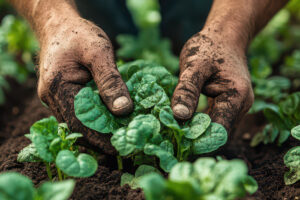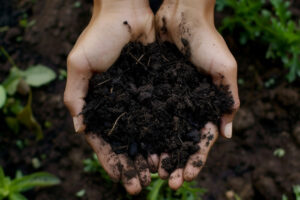Permaculture food forests are designed to mimic nature, and the best way to begin this process is by building soil fertility to eliminate the need for synthetic fertilizers. Two important plant types that contribute to this are nitrogen-fixing plants and dynamic accumulators. They both play crucial roles in the growth and sustainability of food forests. Nitrogen is an essential nutrient for plant growth and development, and many plants cannot absorb it directly from the atmosphere. Nitrogen-fixing plants offer a way to obtain this crucial resource in a free and sustainable way.
Nitrogen is part of the chlorophyll molecule, which plants use in photosynthesis to convert sunlight into energy. Without enough nitrogen, plants will have stunted growth, pale or yellow leaves (chlorosis), and poor fruit or seed development. Nitrogen is the most abundant gas in the atmosphere, but plants can’t use it directly. Nitrate is a more readily usable form of nitrogen, produced from atmospheric nitrogen or organic matter. Nitrate is highly soluble in water, moving easily through the soil to plant roots.
Following Nature’s Cue, But Making It Our Own
This isn’t as complicated as it might sound. In nature, nothing grows alone. Plants form communities, cycle nutrients, and build fertility together over time. By observing these patterns — how legumes fix nitrogen, how deep-rooted plants mine minerals, how mulch forms from fallen leaves — we can learn Nature’s language.
But permaculture isn’t just copying — it’s creative collaboration. How cool is that?? We follow nature’s lead, but we adapt it to our goals, tastes, climate, and needs. Best of all, nature provides for all of our needs for free. Read on to learn all the fascinating “sciency” details…
What Are Nitrogen-Fixing Plants?
Nitrogen-fixing plants convert atmospheric nitrogen into a form usable by plants. This process occurs through a symbiotic relationship with bacteria, primarily from the legume family. These bacteria colonize the plant roots, forming nodules that facilitate nitrogen conversion.
Why Is Nitrogen Fixation Important?
- Improves Soil Fertility – Increases nitrogen levels in the soil, benefiting neighboring plants.
- Reduces Dependency on Synthetic Fertilizers – Supports natural soil enrichment.
- Enhances Plant Growth – Provides essential nutrients for leafy growth and fruit production.
- Supports Ecosystem Stability – Promotes biodiversity and soil microbial life.

Types of Nitrogen-Fixing Plants
When I began studying permaculture, I initially focused on improving the soil before I started to design the food forest (and I’m glad I did). One of the first nitrogen-fixing plants I tried was Pigeon Pea. It’s fast-growing and ended up being an annual here in my growing zone that I could chop and drop as an easy mulch. Since then, I’ve experimented with all kinds of nitrogen fixers. Here are some suggestions for a North Florida food forest like mine:
Leguminous Nitrogen Fixers (Fabaceae family)
- Trees: Black locust (Robinia pseudoacacia), Honey locust (Gleditsia triacanthos), Acacia (Acacia spp.)
- Shrubs: Pigeon Pea (Cajanus Cajun), Chipilin (Crotalaria longirostrata), Gliricidia (Gliricidia sepium)
- Herbaceous plants: Partridge pea (Chamaecrista fasciculata), Red clover (Trifolium pratense), White clover (Trifolium repens), Alfalfa (Medicago sativa), Lupines (Lupinus spp.)
- Vine: Purple Hyacinth Bean (Lablab purpureus), Butterfly Pea (Clitoria ternatea)
- Ground Cover: Perennial peanut (Arachis glabrata, Arachis pintoi), Sunshine Mimosa (Mimosa strigillosa)
Non-Leguminous Nitrogen Fixers
- Trees: Alder (Alnus spp.), Casuarina (Casuarina spp.)
- Shrubs: Goumi berry (Elaeagnus multiflora), Autumn olive (Elaeagnus umbellata), Sea buckthorn (Hippophae rhamnoides), Shepherd’s purse (Capsella bursa-pastoris)
- Herbaceous plants: Mexican sunflower (Tithonia diversifolia)

How to Use Nitrogen-Fixing Plants in a Food Forest
- Natural Fertility Boost
Nitrogen-fixers enrich the soil with bioavailable nitrogen, reducing the need for compost, manure, or synthetic fertilizers. - Soil Structure and Health
Many nitrogen-fixers have deep or fibrous root systems that improve soil aeration, prevent erosion, and increase organic matter. - Support for Companion Plants
When placed strategically in guilds or polycultures, nitrogen-fixers can directly improve the growth and yield of fruit trees and perennial vegetables. - Biodiversity and Habitat Creation
These plants often attract beneficial insects, pollinators, and soil microbes, fostering a healthier ecosystem. - Resilience and Sustainability
Integrating nitrogen-fixers makes your food forest more self-sustaining and resilient to climate variability or nutrient depletion.

What Are Dynamic Accumulators?
Dynamic accumulators are plants that absorb and concentrate essential minerals from the soil into their leaves and roots. These minerals become available to other plants when the accumulators shed leaves, die back, or are used as mulch.
Benefits of Dynamic Accumulators
- Improves Soil Mineral Content – Makes nutrients bioavailable to other plants.
- Enhances Compost Quality – Provides nutrient-rich plant material.
- Reduces Soil Depletion – Helps recycle nutrients from deep in the soil.
- Encourages Deep Root Systems – Prevents erosion and enhances drought resistance.
Favorite Dynamic Accumulators and The Nutrients They Accumulate
- Comfrey (Symphytum spp.) – Nitrogen, phosphorus, potassium, calcium
- Dandelion (Taraxacum officinale) – Potassium, calcium, iron, magnesium
- Yarrow (Achillea millefolium) – Phosphorus, potassium, calcium
- Plantain (Plantago major) – Calcium, sulfur
How to Use Dynamic Accumulators in a Food Forest
- Chop and Drop: Prune leaves regularly and let them decompose as mulch.
- Use in Composting: Add nutrient-rich biomass to compost piles.
- Plant Along Pathways and Borders: Helps stabilize soil while providing biomass.
- Mulch Around Fruit Trees: Enhances tree health and soil fertility.
Nitrogen-Fixers for Each Layer of the Food Forest
Layering in a Food Forest: Traditional permaculture food forests include multiple layers, and nitrogen-fixing species exist for nearly every layer.
- Canopy and Overstory Tree
- Black Locust (Robinia pseudoacacia)
- Fast-growing, excellent for chop-and-drop mulching.
- Mimosa (Albizia julibrissin)
- Ornamental, attracts pollinators.
- Fixes nitrogen and offers light canopy cover.
- Ice Cream Bean (Inga edulis) (Best for subtropical climates)
- A great shade tree with edible pods.
- Rapid nitrogen-fixer and mulch producer.
- 2. Shrubs and Small Trees
- Pigeon Pea (Cajanus cajan)
- Dual-purpose: nitrogen fixer and food crop.
- Grows quickly and provides mulch.
- Ideal for chop-and-drop systems.
- Goumi Berry (Elaeagnus multiflora)
- Fixes nitrogen and produces edible berries.
- Attracts pollinators.
- Pigeon Pea (Cajanus cajan)
- 3. Herbaceous Layer
- Lupines (Lupinus spp.)
- Beautiful flowers that fix nitrogen.
- Cold-season annual or perennial depending on species.
- Comfrey (Symphytum Uplandicum) “Bocking 14”
- Excellent cover crop.
- Grows fast and adds biomass.
- Clover (Trifolium spp.)
- Spreads quickly and covers bare soil.
- Attracts pollinators and improves soil health.
- Lupines (Lupinus spp.)
- 4. Ground Covers and Vines
- Lablab Bean (Lablab purpureus)
- Vigorous climber with edible pods.
- Fixes nitrogen and provides shade.
- Inca Peanut / Sacha Inchi (Plukenetia volubilis)
- Vine that fixes nitrogen.
- Bonus: delicious harvest.
- Perennial Peanut (Arachis glabrata)

Seasonal Management:
- Spring: Plant dynamic accumulators for early nutrient capture.
- Summer: Prune nitrogen fixers to release nutrients into the soil.
- Autumn: Allow leaf drop from dynamic accumulators to enrich the soil.
- Winter: Mulch beds with chopped leaves and stems for slow decomposition.
How to Use Nitrogen-Fixers in Your Food Forest Design
Cover Cropping and Ground Stabilization:
Clover and vetch make excellent living mulches that fix nitrogen, suppress weeds, and prevent erosion between perennial plantings.
Guild Integration:
Include a nitrogen-fixer in each plant guild (a central fruit tree surrounded by companion plants). For example, plant pigeon pea or clover around a young citrus tree.
Succession Planting:
Use fast-growing nitrogen-fixers like pigeon pea early on when developing a food forest to build soil. Later, replace or prune them to make space for longer-lived species.
Chop-and-Drop Mulching:
Prune nitrogen-fixing shrubs and trees regularly to deposit biomass and nitrogen-rich organic matter directly onto the soil.
How do plant guilds create abundance?
Powerful tools for resilient and productive food forests…
Challenges and Considerations
While nitrogen-fixers and dynamic accumulators offer many benefits, a few challenges exist:
- Invasiveness: Some species, like autumn olive and black locust, can spread aggressively.
- Excessive Growth: Legumes can overgrow and require pruning.
- Competition: Deep-rooted accumulators may compete for water with shallow-rooted plants.
To mitigate these issues:
- Choose species suited to the local climate and soil.
- Regularly prune and manage plants.
- Use dynamic accumulators sparingly in areas with nutrient-sensitive plants.
Conclusion: Nitrogen Fixers & Dynamic Accumulators Are Essential
Nitrogen-fixing plants and dynamic accumulators are essential for a sustainable and productive food forest. They improve soil fertility, support plant health, and enhance biodiversity, reducing the need for synthetic fertilizers. By integrating these plants strategically, we can create self-sustaining ecosystems that thrive for generations.
Nitrogen-fixers are an essential element of any successful food forest. They support the system, feeding the soil, benefiting nearby plants, and contributing to a resilient and sustainable ecosystem. Whether you choose to plant a nitrogen-rich cover crop like perennial peanut, a shrub like pigeon pea, or a canopy tree like ice cream bean, you’re investing in the long-term fertility of your land.
Copyright © 2025 Fruitful Food Forestry & Lauren Lynch. No portion of the original content on this website may be reproduced, in any language, without express written consent.
Want to show your gardening style?
Check out our fun products…









Leave a Reply
Your email is safe with us.